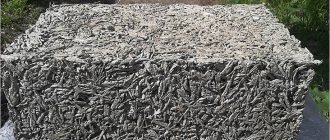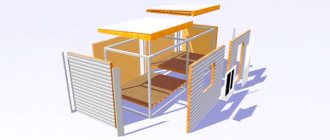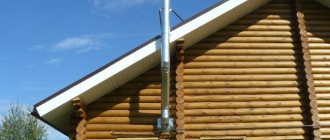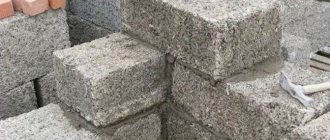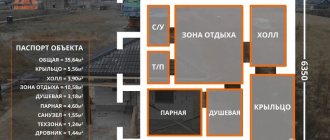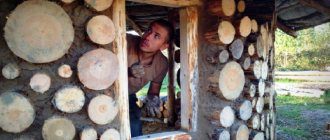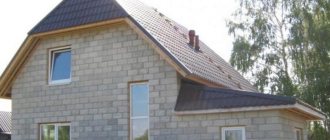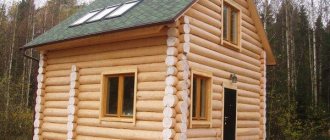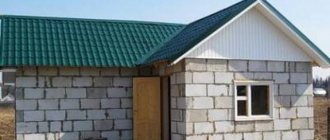Despite the fact that today a bathhouse made of aerated concrete is a popular construction, some people have controversial questions about its quality and reliability. One of the main questions is why timber and logs were replaced with blocks? Why are they better? The main reasons are the rise in price of wood, the complexity of processing, labor intensity, and fragility. The decisive arguments in favor of aerated concrete blocks were affordability, ease of installation, and high speed of construction.
Historical note: In ancient Rome, one of the popular building materials was concrete. Baths were often built from it. Most of which can still be seen today. A modern aerated concrete block is as similar as possible to the concrete of that time. The only difference is that it contains additives that improve the properties of the material. To the question “are bathhouses built from aerated concrete”? The answer is obvious, of course yes.
Is it possible to build a bathhouse from aerated concrete?
Building a bathhouse from aerated concrete is an excellent solution for those who want to save budget and time. Technical progress does not stand still, but the documentation for some types of wall blocks requires revision. According to GOST, cellular concrete cannot be used for the construction of buildings with high humidity - for example, bathhouses, swimming pools, boiler rooms. But, knowing about the excellent physical qualities of the aerated block, which are in many ways similar to those of wood, most experts refute this point in GOST.
What's the matter then? Why is the use of wood for rooms with high humidity not prohibited? Its water absorption coefficient is an order of magnitude higher than that of aerated blocks. It is also not safe, since it supports combustion. Rodents love it; mold, bacteria, and fungi grow and reproduce well on it. When wet, the geometry, etc. is seriously disrupted. The only advantage of wood over aerated concrete is aesthetics, as well as a pleasant smell.
It is important to think through high-quality hydro- and vapor barrier at the initial stage of construction. And the problem with waterlogging is solved. When insulating a bathhouse made of aerated concrete, it is important to follow the principle: increasing the vapor permeability of the wall materials when viewing it from the inside out.
The nuances of building an aerated concrete bath
So, we build a bathhouse with our own hands from aerated concrete
Let us pay attention to the most important points that affect the performance of the finished building
Foundation design
Before building a bathhouse from aerated concrete, it is necessary to prepare a reliable foundation. What does reliable mean?
It should be a structure that, due to its rigidity, maximally compensates for the effects of soil settlement. Only reinforced concrete can be considered as such - no wooden or metal piles.
More precisely, metal piles can be used, but they must be tied on top with a monolithic grillage. This is the same tape, only “suspended” above ground level.
4 types of foundations for aerated concrete walls
Floor construction
Depending on which foundation option is taken as a basis, the floor structure is also selected.
Let's present the 3 most commonly used ways of structuring it:
| Floor design | A comment |
| Expanded clay screed | This version of the floor design is called frame, as it is arranged on beams. It is provided in bathhouses, at the base of which there is a strip foundation (or a point foundation with a grillage). The subfloor in the form of boards or sheets of plywood is mounted here between the side edges of the beams, to which the skull blocks are first nailed. The flooring is completely covered with waterproofing material (for example, two layers of polyethylene), after which the remaining space between the joists is filled with fine-grained expanded clay. The minimum backfill thickness is 10 cm, which may exceed the cross-sectional height of the beams. A sand-concrete screed is made on top of the expanded clay; if necessary, heated floor pipes are laid in it. A drain hole must be provided in the center of the washing room, towards which the screed must have a slope. For the convenience of walking on such a floor, a ladder is installed on it in the form of a lattice made of 30*50 mm bars - or the surface is lined with porcelain stoneware. |
| Option with polystyrene foam insulation and dry screed | The second floor option has the following structure:
|
| Floor with a container for collecting water, arranged on the ground | If the bathhouse is built according to a project in which a slab foundation is laid, a floor configuration in the washing compartment such as in the photo will already be provided. When building on strip or column foundations, such a floor is laid on the ground. In the center it has a U-shaped recess for collecting water, from which it goes through a drain pipe into a cesspool or drainage well. The slope here is greater, so support pillars made of brick are provided for installing the ladder. |
As you can see, bath floors have a rather complex design, and for comfortable operation of the bath it is very important to structure them correctly. Floors in the washing area lined with porcelain stoneware
Floors in the washing area lined with porcelain stoneware
How to properly build a bathhouse from aerated concrete blocks with your own hands
Before the start of construction work on the bani, a project for the future construction is drawn up and an estimate is agreed upon. Building a bathhouse from aerated concrete with your own hands - consider in the form of a table the acceptable and undesirable places for construction.
| Allowed | Not recommended |
| We build a bathhouse from aerated concrete 15-25 m from the reservoir | Windward placement |
| Ravine placement | Select wetlands |
| Orientation relative to existing buildings | Build on the first line near the reservoir |
| Must be visible from the windows of the house | Place waste pipes directly into water |
| Entrance from the south side of the building (due to climatic conditions) | Build close to the neighbor's fence. |
| Installation of windows from the west, southwest for maximum natural light |
Next, we will consider what a bathhouse made of aerated concrete is, the pros and cons of this building material.
Specifics of aerated concrete
Aerated concrete is a building material from the cellular concrete family. It was created about 100 years ago with the goal of obtaining a light and warm material for the construction of economical housing. The creators of aerated concrete managed to fulfill their task. They managed to obtain a material with low thermal conductivity and low weight, which allows saving on the foundation and heating of the house. These advantages appeared due to the porous structure. The mass of aerated concrete is replete with small (2-4 mm) air-gas cavities, which give the material all its working qualities, both positive and negative. The material is soft and friable and does not withstand compression and tension loads. In addition, aerated concrete is hygroscopic and easily absorbs moisture. This property is typical for all types of concrete, but gas silicate not only absorbs, but accumulates moisture inside air bubbles.
This is a dangerous property, since in winter the water freezes, expands and ruptures the material from the inside, like an explosion stretched over several months or years. This is the most undesirable scenario for the development of events, but less dangerous options are little better - wet gas silicate is not able to retain heat, it becomes heavier and begins to overload the supporting structures.
Because of these qualities, aerated concrete must be protected from contact with moisture by all available methods. The outside of the material is finished with plaster, cladding and cladding are installed. The inside is plastered and painted, and covered with wallpaper. The specifics of these works differ little from the general rules that require the possibility of drying the material. To do this, it is necessary that the permeability of the finishing layers inside is minimal, and outside - maximum. This is the only option that ensures normal removal of moisture from the walls. Otherwise, water will begin to accumulate inside the pores of aerated concrete and create conditions for the destruction of the building.
Pros and cons of building a bathhouse from aerated concrete
Anyone can build a bathhouse from aerated concrete with their own hands. The main thing is to study all the nuances of the gas block. It retains heat well and has excellent performance properties. Banya warms up much faster compared to the same brick one. The cost of a bathhouse made of aerated concrete is noticeably lower than the price of logs; the same timber costs 2 times more, brick – 1.5 times. The percentage of building shrinkage is minimal. This advantage is especially appreciated when carrying out interior finishing work. Aerated concrete blocks are a non-flammable material and are highly resistant to biological attack. Working with him is easy and simple. The blocks are lightweight, so there are no strict requirements for the foundation. The construction of the structure is carried out in record time.
The main, and perhaps the only drawback is hygroscopicity, that is, the ability of the material to absorb moisture. This minus should definitely be taken into account and avoided in the future. The best option for interior decoration of a bathhouse is lining, and for exterior decoration - facing bricks. Disadvantages can be found in absolutely any building material. In the case of aerated concrete blocks, their operational and technical indicators are fully covered by their advantages. More and more often you can find a positive review of a bathhouse made of aerated concrete blocks rather than wood.
Video description
Video review of the characteristics of an aerated concrete bath:
- Reinforcement of openings.
Even if the walls were laid without reinforcement, strengthening the walls under the openings is mandatory in any case. For each opening, take 2 rods with a thickness of at least 8 mm and a length greater than the size of the opening by 25 cm on each side.
Preparation of grooves, laying and filling them with cement mortar or glue is carried out using standard reinforcement technology. After they are cemented, a series of blocks are laid on top.
- Arrangement of jumpers.
To form lintels on top of the openings, U-shaped blocks are used. Before starting masonry, a T-shaped support is installed in the door or window. Then they begin to lay blocks on top of it with their cavities facing up. After fixing them with glue, a pre-fabricated reinforcement frame of suitable dimensions is mounted inside.
After this, it is filled with mortar. At least 2 more rows of ordinary blocks are laid on top of the lintels to complete the laying of the walls. Continuation of the masonry is available the very next day after pouring the reinforcing frame. The T-shaped support, as a rule, is dismantled at the stage of interior finishing of the bathhouse, when the aerated concrete masonry has already acquired sufficient strength.
Stages of work, from a to z
You can calculate the project yourself on our website in the section: Online aerated concrete block calculator
- Let's calculate the project
The construction of any building should always begin with a well-designed project. It is in it that data on areas, number of rooms, wall heights, materials, their quantity, etc. is displayed. If there is no project, then at a minimum there should be sketches with data on the future structure. Besides:
- It is important to consider the input and distribution of electricity, water, and sewerage systems. This will allow you to create a more accurate estimate for upcoming expenses.
- To select the right type of foundation and what thickness of the walls of aerated concrete bathhouse will be most optimal, you can use ready-made design solutions on construction sites. Even if, instead of a bathhouse, there are calculations for a guest house with an attic, this data can be taken as the basis for calculations.
- The thickness of aerated concrete for a bathhouse, namely the walls themselves, is 300-400 mm for residents of central Russia
- Preference is most often given to a foundation made of a monolithic slab. This is considered the simplest and least labor-intensive option.
A popular version of a bathhouse is a building measuring 3*4 m, with 3 rooms (dressing room, washing room and steam room) and two windows.
How to calculate the number of gas blocks per bathhouse
Now let's proceed directly to the calculations themselves. After you have chosen the thickness of the walls and partitions, we proceed to counting the required number of blocks. Let's consider an example: for external walls we take a block with dimensions of 600 * 300 * 200 mm, and for internal walls 600 * 75 * 200 mm. The sizes of the blocks are the same, the only difference is the width, so we carry out the calculations separately.
- Let's take the size of the bathhouse 3*5 m. We get the perimeter of the walls = 16 linear meters. The height of the walls is 2.5 m. From here we calculate the area = 40 m2.
- Next, we subtract the area of the openings (we have two windows and a door). The size of the windows is 100*50 cm and 50*50 cm, the doors - 200*90 cm. We calculate the area, add it up and get the final result - 2.55 m2, which we then subtract from the total square footage. Total= 40m2-2.55m2=37.45m2
- For our region, the wall thickness is 30 cm. Multiply 37.45 m2 * 0.3 = 11.235 m3. We add 5% of the material supply to the estimate. Total = 11.835 m3 of wall material.
- Now we calculate the number of blocks for the internal walls. The algorithm is similar, the only thing in point 3 is that instead of 0.3 we substitute 0.075m.
Depending on the chosen solution for the design of the armored belt, you have two options: buy ready-made U-blocks or regular ones.
Beautiful examples
Many consumers are skeptical about block baths, explaining this by their unsightly design. In fact, such buildings can be made very stylish and attractive not only inside, but also outside.
For example, a small building with a triangular roof and steps leading to a dressing room can be finished with light-colored siding panels. The lower part of the building should be lined with decorative brown bricks around the perimeter. In such a bathhouse, blue or purple tiles will stand out effectively.
At the entrance to the building, place brick columns and install a red tile roof on top, which would cover the entire structure as a whole (along with the terrace). Green plants and flowers should be planted around. As a result, you will get a very impressive bathhouse.
A bathhouse made of blocks can be made laconic, but no less attractive, by playing on the contrast of the walls and roof. For example, the external finishing of block ceilings should be done with snow-white or beige plaster/paint, and brown coverings should be chosen for the roof. Install high plastic windows and doors in such a structure. This will make the bathhouse more stylish and modern.
Gas blocks: dimensions and characteristics
Dimensions refer to the height and length of the blocks themselves. These data are standard 625*250, but the width may differ and vary from 100 to 600 mm. The wider the wall and the higher the grade of aerated concrete, the higher you can build a house, and also use monolithic concrete floors. The thinner the wall, the less stable it is.
Density
Marked with a letter and a number, for example, D300. The higher the density, the higher the strength and thermal conductivity of the material. For the construction of a bathhouse, blocks with density and strength indicators D400 and B2.5, respectively, are suitable.
Thermal conductivity
This is the property of a material to release thermal energy. The advantage is low thermal conductivity. The average is 0.14 W/m*S. Heat transfer resistance d500. The higher this indicator, the better the layers of aerated block resist heat transfer. For example, with a wall thickness of 300 mm, this figure is 2.67 m²*C/W, while for a brick wall this parameter is only 1.09 m²*C/W.
Heat capacity
This parameter shows how quickly it is possible to heat a bathhouse. Since we are considering which bathhouse made of aerated concrete or wood is better, we will compare these two indicators. The heat capacity of a gas block is 0.84 kJ/kg*C, wood - 2.4 kJ/kg*C. It follows that a wooden bathhouse takes much longer to warm up. First the walls heat up, and only then the air in the room.
Tips and tricks
Reviews from owners of block baths are usually positive. Especially those who did the construction themselves. Most often, among the wide variety of blocks, buyers highlight aerated concrete and foam concrete. Indicating that these materials fit better, have blocks that are the same in shape and size, do not shrink at all and delight with their simplicity when working with them.
As for building a bathhouse from blocks, experts willingly share their tips and recommendations, paying attention to the most basic of them:
The location for the block steam room must be chosen after weighing all the important nuances. The building should be well removed from the well so as not to pollute drinking water. And also in order to avoid even the slightest possibility of fire, the bathhouse should be located away from the residential building. And it is equidistant from each tree on the site (the approximate sufficient distance is 10-15 meters).
- When arranging drains, you should definitely dig a separate drainage hole for the bathhouse. Experts do not recommend connecting it to a common drain, since bath emissions are quite large and powerful, which can negatively affect the condition of your common drain “well.”
- All sewer and water pipes for the bathhouse are placed on a sand bed in the same way as a strip foundation.
- Each porous material for bath walls has its own base size. For example, cinder blocks and expanded clay concrete are best and most stable on a foundation 50 cm high from ground level.
- For all types of foamed concrete blocks, a hinged ventilated façade is best suited. It has a beautiful appearance. It will also eliminate the problem of condensation between the wall and the cladding.
How thick are the blocks needed to build a bathhouse?
Having examined the characteristics, let’s return to the question of how to make a bathhouse from aerated concrete, namely, what wall thickness to choose. Since the bathhouse is not intended for year-round use, and it is heated only periodically, precise calculations are not required in this case. The reference point is the region of residence. For example, for the southern strip, a wall thickness of 30 cm is sufficient. Or you can make it smaller, 20 cm, provided that thermal efficiency is maintained by increasing the thickness of the insulation. Is it necessary to insulate a bathhouse made of aerated concrete? The answer is yes, regardless of your region of residence. This is necessary for faster and better heating.
On a note! It is possible to carry out facing work without insulation, but in compliance with the ventilation gap. If brick is chosen as the exterior decoration, then it is necessary to organize ventilation.
For temperate climates, the thickness of aerated concrete walls is 37.5-40 cm, and for regions with a harsh climate, 50 cm. Thermal insulation of external walls is mandatory. An alternative to standard insulation can be the gas block itself. How to insulate a bathhouse made of aerated concrete in this case? A block with lower density values is selected. This insulation option is considered the most durable.
External insulation, dew point
When considering the removal of steam from porous walls, it is necessary to understand the physical essence of the processes occurring. If moisture in a gaseous state is absorbed into aerated concrete from the inside, then liquid water evaporates from the outside. This occurs due to a decrease in the temperature of the outer layers of the wall. There is a concept - dew point. This is a conditional plane inside the walls in which the transition of steam into a liquid state occurs. It is called a point, since the very appearance of the term is associated with graphic images of walls in section, where the transition area is displayed as a point.
Water vapor, absorbed from the inside, spreads throughout the entire volume and reaches a region of low temperature, at which condensation occurs and liquid forms. This is a common occurrence, but for external walls it does not bode well. Removing liquid moisture is more difficult and takes more time. At the same time, steam flows from inside as usual. Water begins to accumulate, the wall becomes wet and ceases to perform heat-insulating functions. In winter, another area appears - the zero point. In it, water turns into a solid state, that is, it freezes. An insurmountable barrier arises, the removal of moisture from the walls stops, creating conditions for the destruction of the wall material.
If there is no external insulation, dew and zero points appear inside the walls. However, if a layer of thermal insulation is installed outside, both planes move outward. When installing a sufficiently thick layer of insulation, both areas are outside the aerated concrete, the material retains its working qualities.
Material for external insulation
It is important that the thermal insulation is permeable to water vapor and does not interfere with the drying of the outer surface of the walls. For this purpose, mineral wool is used; it is the only fairly effective and inexpensive vapor-permeable insulator. There are a lot of videos online that demonstrate external insulation using polystyrene foam or penoplex. This is the wrong approach since both materials are impervious to moisture. They trap steam inside the walls and contribute to their getting wet, which sooner or later will lead to dire consequences (destruction of materials). At the same time, it is necessary to take into account that visual monitoring of the condition of gas silicate blocks will be impossible - they are covered on both sides with several layers of thermal insulation and finishing. Therefore, it is possible to detect the results of an incorrect choice of thermal insulation only in the final stage, when the walls require major repairs.
If an impenetrable heat insulator has already been installed on the outside, there is no need to rush to dismantle it. the problem can be solved in another way - by installing a reliable cutoff of the walls from moisture from the inside, as well as organizing high-quality ventilation of the interior. Here you will need the help of specialists who can calculate the standard air exchange and select equipment with the ability to heat the supply flow.
Foundation for a bathhouse made of aerated concrete
Since the gas block is lightweight, it is recommended to install a strip foundation. An important determining criterion is the type of soil. Where it is unstable, preference is given to a strip foundation on piles. Only a specialist can determine which foundation for an aerated concrete bathhouse is suitable for your site.
Ventilation in aerated concrete bath
As a rule, dense cold air masses tend downward (they are quite heavy), while warm ones are displaced by them and tend to rise. In this way, air moves in the building where there is a heating installation. If there is no influx of fresh air, then renewal does not occur. Air masses simply move in a circle. The simplest option is natural ventilation in a bathhouse made of aerated concrete. This is when holes are made at the bottom and top of the wall. Fresh air comes in through the bottom, and out through the top. This type of ventilation is quite sufficient for a small bathhouse. The main thing is to choose the right places to make holes.
Internal insulation with tight installation of the insulator to the wall
Internal insulation of a bathhouse made of gas silicate blocks is carried out in different ways. The most common option is to install thermal insulation material close to the wall. This method saves internal space, simplifies and speeds up work.
As a rule, the material is installed directly on a wall made of aerated concrete. They use adhesive compositions (adhesive for laying aerated concrete or tile adhesive is suitable), as well as mechanical fastening with dowels and screws. The first option is more labor-intensive, but effective and reliable. The absence of a gap between the wall and the insulator prevents moisture from entering from the air, condensation and wetting of the aerated concrete. Fastening with screws is less dense and can cause moisture to enter the gas blocks. In practice, they usually combine both options - stick the insulator on the wall and fix it with screws so as not to delay the work.
If an impermeable material is used, a vapor barrier can be dispensed with. Sheets of foam plastic (penoplex) or strips of foamed polyethylene are installed tightly to each other, the cracks are filled with polyurethane foam and taped with aluminum tape. However, it is necessary to remember the numerous points of passage of pipes, wires, brackets and other structural elements. Each area must be carefully sealed using foam or silicone plumbing sealant.
Technology and features of wall masonry
The first step is to carry out external markings and install a boundary rope. Deviations in the height of the foundation of more than 4 cm are not allowed. The construction of walls begins with the formation of corners. The blocks are laid using special glue using a trowel. The first row is laid on a concrete composition, and the blocks themselves are placed together on an adhesive solution. After laying the 1st row, you must wait 5 hours for the concrete composition to gain strength and the blocks to become motionless.
The laying of subsequent rows is carried out using an adhesive composition with an optimal percentage of block displacement of 50%. Just like the first row, the masonry starts from the corner. To level the surface, use a sanding board.
Construction technology
Bathhouse foundation
As mentioned earlier, these designs belong to the lightweight category. Therefore, they do not require a capital, powerful foundation. Depending on the location of the building, you can use a shallow strip foundation, a strip-column foundation, or in swampy areas a columnar foundation for a bathhouse.
We will consider the most common type of foundation, strip.
- Naturally, we start by marking the territory; to do this, we need to take measurements, drive in wooden or metal pegs and stretch a fishing line between them, marking the outline of the future foundation. The width of the foundation is made wider than the wall by 150 - 200 mm.
- According to the rules, a strip foundation is laid at a depth slightly below the freezing point in a given area.
- Next, a trench is dug and a layer of sand of at least 100 mm is poured onto the bottom with the first ball and compacted. A layer of gravel is poured onto the sand in approximately the same layer and compacted.
- After this, one layer of roofing material is laid for waterproofing and formwork can be installed on this layer.
- Next, the reinforcing structure is installed. The thickness of the reinforcing rod must be at least 12 mm. The rod can be welded by electric welding or simply tied with pre-burnt steel wire.
Classic strip foundation.
We build walls
Setting the angle.
- A bathhouse made of aerated concrete blocks, when the foundation is ready, is erected quite quickly. Initially, you need to lay a layer of waterproofing on the foundation in the form of 2 - 3 layers of roofing material.
- Next, the first row is laid. You need to start laying the first row by installing corner blocks. The first row is fastened to the foundation using ordinary cement-sand mortar, the thickness of the seam is about 12 - 15 mm.
- The blocks are fastened together with a special glue, which initially comes in dry form and is diluted in a special container with water only before use. A special attachment for an electric drill is used for stirring.
Applying glue to blocks.
Block cutting.
- The solution is applied to the blocks with special trowels for laying aerated concrete blocks. It rarely happens that the distance between two corner blocks is a clear multiple of the length of the block. When it is necessary to cut a block, a special limiter is installed on the edge of the product and cut using a regular hacksaw. Glue is applied to aerated concrete both horizontally and from the ends.
- After laying each subsequent row of aerated concrete, it should be sanded well with sandpaper, and the dust should be thoroughly swept away.
- Tray blocks are used to lay the top layer of windows and doors. Initially, a wooden support is made under the upper level of a window or door, U-shaped tray blocks are laid on it, a reinforcement frame is laid in them and concrete is poured.
Reinforcement of tray blocks.
For partitions, special configurations of products in the form of large bricks are also used, which are connected, like the main walls, with an adhesive mortar.
Wall decoration
Aerated concrete itself is a good heat insulator, but it absorbs moisture. Proper interior finishing of aerated concrete baths can solve this problem.
First of all, it is important to understand that the walls should not be rigidly waterproofed
Because after several freezing they can burst, the walls must breathe.
The plaster should act as a vapor barrier, that is, allow evaporation to pass only in one direction, to the outside.
Applying plaster to the reinforcing mesh.
- Initially, the walls are well rubbed with sandpaper in order to level out all the unevenness, after which all chips and potholes can be repaired with the same adhesive solution on which the blocks were attached.
- All plaster mixtures should be purchased specialized specifically for aerated concrete. Their price is relatively small, but in this case the quality of the finish will be guaranteed.
- Next, 2–3 layers of soil are applied to the wall, beacons and reinforcing mesh are attached. An initial, thick layer of rough plaster is laid on the reinforcing mesh. And the finishing plaster is already applied to it, along the beacons.
- After completing the internal plastering work, a reflective layer of foil is installed in the steam room and linden lining is filled. In all other rooms of the bathhouse, you can simply lay tiles or cover them with clapboard.
Installed beacons.
Waterproofing the base for masonry walls
Once the base has dried, inspection is carried out using a level. All defects are eliminated with masonry composition. Waterproofing aerated concrete in a bathhouse is a very important stage. You will need bitumen mastic and roofing felt. Overlapping of the rolled material is allowed up to 15 cm.
On a note! Previously, the foundation and masonry were separated by ceramic bricks. After time, it turned out that the brick did not create a protective “shell” against cracking of the walls, and also did not impart strength to the building. Conclusion: this step is optional.
Partitions
What should be the partition in a bathhouse made of aerated concrete, or rather its thickness? For the construction of partitions up to 3 m in height, it is recommended to choose blocks of a grade not lower than D 400. The most optimal option is D 500-D 600. The higher the grade, the better the load-bearing capacity. The thickness of the internal walls is chosen based on whether it is load-bearing or not. If the partition is load-bearing, then it is necessary to carry out calculations according to the mind. If the wall is not load-bearing, then another indicator is used - height. When constructing a partition up to 3 m high, it is sufficient to use blocks 10 cm wide; over 3 m and up to 5 m, the block width will be 20 cm.
Steam room insulation
The steam room is the hottest and most humid room in the bathhouse. Here it is necessary not only to insulate the walls from contact with hot air, but also to cut them off from the absorption of steam. As a rule, thermal insulation of a steam room is implemented in the form of a continuous insulating box along the planes of the walls and ceiling. The insulation is installed in a continuous layer over all surfaces, filling the cracks with foam. The best option is to install polyethylene foam with the foil side facing the inside of the room. This will reflect the infrared rays back into the steam room and retain thermal energy.
Horizontal planks are installed on top of the thermal insulation material on the wall and wooden sheathing is mounted. It is also an element of insulation, since wood has low thermal conductivity. In addition, the cladding creates an additional barrier to water vapor (wood is impermeable to moisture, although it tends to absorb it). Not only the walls are sheathed, but also the ceiling. Here it is necessary to carry out the electrical wiring in advance, sealing the points where the cable passes through the heat-insulating material. As a rule, lamps are placed on walls or ceilings. In addition, you need to take care of the laying of air ducts (if forced ventilation is used). This is an important point, since it is impossible to carry out ventilation after installing thermal insulation and sheathing on the walls - the external arrangement of the pipes looks sloppy. In addition, the air ducts become very hot and become dangerous for users.
The floor is insulated during the construction process, since it is necessary to lay the floor covering (tiles) with a slope to drain the water. Therefore, insulation of the floor in the steam room is carried out according to the usual scheme for all rooms of the bathhouse. Sometimes it is made of wood, so as not to use a platform, but to walk directly on the boardwalk. This option is convenient and practical, but it becomes more difficult to dry such a floor - the underside of the boards gives off moisture worse, which can cause rotting.
Ceiling in a bathhouse made of aerated concrete
The ceiling in a bathhouse made of aerated concrete can be made in several versions. It all depends on the intended purpose. If the attic of the bathhouse will be used as an attic, the household. premises, etc., then the ceiling structure must withstand serious loads. Simply put, be highly reliable. Even if the attic space is not planned for further use, the ceiling structure must support its weight and a layer of thermal insulation. In order not to heat the street, you should choose high-quality thermal insulation that is not afraid of moisture and high temperatures. For example, the use of certain tree species together with special means to extend the life of wood.
Interior of a 3x4 bathhouse: layout, photos, ideas
The shelves should be of such length that you can lie on them at full height.
The shelves should be of such length that you can lie on them at full height.
It is also important to maintain a distance from the shelves to the ceiling: it is unacceptable that when you get up, you touch the ceiling. It is recommended to make two-tier shelves or compartments in the steam room, in which case its capacity will increase
The shelves should be of such length that you can lie on them at full height.
It is recommended to make two-tier shelves or compartments in the steam room, in which case its capacity will increase. The shelves should be of such length that you can lie on them at full height.
In the washing room you can put a shower stall or a tray with a tub. Create small shelves to store shower accessories.
The rest room must have places to sit and a table. It is better to place benches rather than chairs as they take up less space but have more capacity.
A folding table can help save space. If necessary, you can always fold it, thereby freeing up precious meters in the room.
If the project provides for a dressing room, then you need to hang clothes hooks in it; if there are none, then they need to be installed in the rest room.
Be sure to add small little things for decoration: paintings, bath caps (they are used not only for decoration, but also protect the head from overheating), various figurines and other details. Little things like this help create an atmospheric and cozy environment that sets you up for relaxation.
Bathhouse roof made of aerated concrete
Often the roof of a bathhouse made of aerated concrete is gable. The most popular finishing material is metal tiles. When calculating the material, the type of roof, the length of the base and width, the length of the overhangs, and the height of the roof are taken into account. The height and angle of inclination of the slopes are formed by gables made of aerated concrete. But often the end of the bathhouse roof is covered with a board. Insulation is carried out over the ceiling. A membrane is installed on top of the rafters. The rafter system depends on the type of roof and the roofing material itself.
Video description
Video instructions for laying aerated concrete blocks:
- Roofing system installation.
The assembly of the roofing system is preceded by the formation of an armored belt. The simplest way to make it is to complete the last row using U-shaped blocks and then install a frame and pins in them to fix the Mauerlat. The latter is formed from timber along all 4 walls. The subsequent process of forming the roof comes down to the following steps:
- Crossbars and rafters and beams for the attic floor are attached to the Mauerlat.
- The attic floor is being installed.
- The sheathing is laid on top of the rafter system.
- In accordance with the technology, insulation is laid on top of the slats, as well as the necessary vapor and waterproofing materials.
- The roof deck is being installed.
At the final stage, the walls of the bathhouse are finished. In this case, the inside of the surface must be covered with a waterproofing layer, for example, putty. Only after this is it allowed to decorate it, for example, with alder paneling.
Bathhouse made of aerated concrete or wood
If we consider whether it is better to build a bathhouse from wood or aerated concrete, then the advantages of the second material option, namely aerated concrete, are noticeably greater. This is due to the fact that wood must be periodically treated with special antiseptic agents to protect against mold, fungi, and rodents. Mandatory sealing of the joints between logs/beams is also required. This event must be repeated several times. And caulking joints is still fun. Another compelling argument why it is worth building a bathhouse from aerated concrete blocks rather than wood - a wooden bathhouse is always an increased source of fire hazard.
What is better for a bathhouse: aerated concrete or foam concrete?
What is better to choose for building a bathhouse? The weight, hardness and specific strength coefficients of these two materials are approximately equal. But as for performance indicators, there are noticeable differences (see table below).
How do we see the question “what is better for a bathhouse, aerated concrete or foam concrete”? – definitely the first option. As for convenience in construction, the geometry of the material, the gas block is manufactured at the factory, but the foam block is made in semi-handicraft conditions, so the geometric parameters of the foam block can noticeably suffer.
Internal or external insulation?
Many users often have a question: what type of bath insulation to choose, from the inside or the outside. The question is not idle, since the bathhouse is different from residential premises, it is used periodically and is not heated constantly. Installation of thermal insulation material from the inside in this case is mandatory. Is it also necessary to insulate the outside if the walls are still excluded from the thermal contour of the building?
Various sources claim that the best option would be to simultaneously insulate the walls from the inside and outside. This option will provide maximum heat saving efficiency and will save fuel for heating the bath. However, experienced bathhouse owners claim that this method is only good for large buildings with recreation rooms, swimming pools and other departments. They have a large wall area with high heat loss. For a small bathhouse, it is quite enough to properly insulate the walls from the inside, and on the outside you can simply install sheathing with a ventilated gap. Thermal insulation in this case is excessive; there is nothing to protect the cold walls from. Therefore, you need to be guided by the size of the bath and the mode of its use.
Foam block bathhouse after 10 years
According to numerous reviews, you can find ones where owners note shortcomings that they personally encountered. After some time, delamination and cracking of the foam block was observed. This is due to temperature fluctuations. The second popular negative review is the formation of mold. Most likely, the reasons for these shortcomings are non-compliance with the construction technology of a foam block bathhouse, the wrong time of year for constructing the structure, an ill-thought-out ventilation system, etc.
Price of aerated concrete bath
How much a bathhouse made of aerated concrete will cost depends on many factors, for example, area, number of rooms, roofing material, type of finishing, etc. Will you draw up a project yourself or build according to a standard solution?
Where to buy Bonolit products - Dealers and partners Bonolit Club
If you have a choice to build a bathhouse from wood or aerated concrete blocks, then it is more profitable, easier and faster to build a structure from aerated concrete blocks.
Start of operation after construction
You have built a bathhouse and you can take a steam bath - unfortunately, this does not apply to buildings made of wood. This is due to the fact that the tree needs time to stand, dry and shrink as required. If you pass by this stage, there is a high probability of cracks appearing. And, as a result, destruction of the finish on all sides. For example: radial shrinkage of pine – 6%. This suggests that the frame of a bathhouse with a height of 2.5 meters will shrink by about 13-15 cm. And if finishing is also done, then get ready to seal the gaps.
On a note! Absolutely any type of tree can dry out.
Compared to wood, aerated block has a minimal shrinkage coefficient of about 0.4%. This way you can start finishing work almost immediately. This means that as soon as the finishing work is completed, the bathhouse can be put into direct operation.
Project
As with the construction of any other building, the design of a bathhouse must be approached scrupulously and responsibly. The first step is to draw up a plan for your project. The convenience of the block design is that they are suitable even for the smallest - two- or three-room bathhouse.
So, before we start construction, let’s look at the most common and successful drawings of standard sizes.
- To place a small structure with maximum convenience, you need to do everything right. In this case, both external and internal layout are very important. The minimum area of a steam room is considered to be a house measuring 4x3 m. Here you can make a project for a small two-room house, where a steam room complete with a washing room is quite conveniently located, and the relaxation room can also be used as a small corner for storing bath accessories. This project is highly functional despite its small dimensions. A 3x4 m bathhouse can be built even on a small plot of land or attached to a summer house.
- The next popular size of block baths is slightly larger - 3 by 5 meters. There are also only two rooms here. As in the first option, the steam room is adjacent to the sink without a partition and occupies an area of 9 m². The hallway is only 6 square meters. At the same time, the bathhouse is equipped with everything necessary: a shower with a drain, a stove with a tank for hot water and shelves, usually two-tiered.
- Another project for a bathhouse with an area of 3x5 m. Here you can already make three rooms, despite the small space. Let's look at how this was achieved. There is a comfortable dressing room - a relaxation room. Now 9 m² are allocated for it. The steam room and sink have dimensions of 4 and 2 square meters, respectively.
- An example of a square bathhouse 4 by 4 meters allows you to place everything in its place and absolutely geometrically evenly. The same three rooms as in the third option. Only the steam room and sink this time have the same area of 4 m², and the dressing room with the guest area is located on 8 squares. Modern craftsmen manage to make a 4x4 m block bathhouse even with an attic. But this should be taken care of at the stage of laying the foundation for the appropriate height of the building.
- Large baths are a pleasure to create. For example, a comfortable size is 5x4 m. Here you can already walk up to an open or closed terrace, and also more calmly plan an attic floor with a sleeping area placed on it.
- 6x4 m is the best option for a bathhouse on a large area. This design looks great as a separate room. The main thing is that all the main communications are connected to it and work as smoothly as possible. Let's consider a project that can easily accommodate a company of 6 people at the same time. The bathhouse is also equipped with an outdoor terrace. All rooms are isolated. Washing room and steam room - 4 square meters each. Guest area + dressing room – 8 m², and terrace – 8 square meters. In the warm season, you can sit almost in the lap of nature after active steaming.
For bathhouses made from large-area blocks, original and spacious designs are provided. For example, a square building with an area of 6 by 6 meters can be considered a full-fledged house for active recreation. A 10x4 m bathhouse can be easily arranged in such a way as to accommodate more tiers of shelves.
Conclusion on the article
Is it possible to build a bathhouse from aerated concrete? The construction of a bathhouse from an aerated block requires significantly less expenditure compared to the same timber or log. The sauna warms up much faster and retains heat well. The building can be quickly erected and operated in the near future. The absence of mold, mildew, and rodents is guaranteed. Most importantly, a sauna made of aerated concrete is fireproof. Perhaps these arguments are enough to say goodbye to the long-standing stereotype that a bathhouse can be built exclusively from wood.
